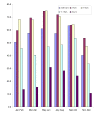Epidemiology of malaria in the forest-savanna transitional zone of Ghana
- PMID: 19785766
- PMCID: PMC2765449
- DOI: 10.1186/1475-2875-8-220
Epidemiology of malaria in the forest-savanna transitional zone of Ghana
Abstract
Background: Information on the epidemiology of malaria is essential for designing and interpreting results of clinical trials of drugs, vaccines and other interventions. As a background to the establishment of a site for anti-malarial drugs and vaccine trials, the epidemiology of malaria in a rural site in central Ghana was investigated.
Methods: Active surveillance of clinical malaria was carried out in a cohort of children below five years of age (n = 335) and the prevalence of malaria was estimated in a cohort of subjects of all ages (n = 1484) over a 12-month period. Participants were sampled from clusters drawn around sixteen index houses randomly selected from a total of about 22,000 houses within the study area. The child cohort was visited thrice weekly to screen for any illness and a blood slide was taken if a child had a history of fever or a temperature greater than or equal to 37.5 degree Celsius. The all-age cohort was screened for malaria once every eight weeks over a 12-month period. Estimation of Entomological Inoculation Rate (EIR) and characterization of Anopheline malaria vectors in the study area were also carried out.
Results: The average parasite prevalence in the all age cohort was 58% (95% CI: 56.9, 59.4). In children below five years of age, the average prevalence was 64% (95% CI: 61.9, 66.0). Geometric mean parasite densities decreased significantly with increasing age. More than 50% of all children less than 10 years of age were anaemic. Children less than 5 years of age had as many as seven malaria attacks per child per year. The attack rates decreased significantly with increasing cut-offs of parasite density. The average Multiplicity of Infection (MOI) was of 6.1. All three pyrimethamine resistance mutant alleles of the Plasmodium falciparum dhfr gene were prevalent in this population and 25% of infections had a fourth mutant of pfdhps-A437G. The main vectors were Anopheles funestus and Anopheles gambiae and the EIR was 269 infective bites per person per year.
Conclusion: The transmission of malaria in the forest-savanna region of central Ghana is high and perennial and this is an appropriate site for conducting clinical trials of anti-malarial drugs and vaccines.
Figures







References
-
- Breman JG, Egan A, Keusch GT. The intolerable burden of malaria: a new look at the numbers. Am J Trop Med Hyg. 2001;64:iv–vii. - PubMed
-
- World Health Organisation The World Health Report. Fighting disease, fostering development. Geneva. 1996.
-
- World Health Organisation Guidelines for the evaluation of Plasmodium falciparum vaccines in populations exposed to natural infections. TDR/MAL/VAC/97 Geneva. 1997.
-
- Murphy SC, Breman JG. Gaps in the childhood malaria burden in Africa: cerebral malaria, neurological sequelae, anemia, respiratory distress, hypoglycemia, and complications of pregnancy. Am J Trop Med Hyg. 2001;64:57–67. - PubMed
-
- Commey JOO, Mills-Tetteh D, Philps BJ. Cerebral malaria in Accra. Ghana Med J. 1980;19:68–72.
Publication types
MeSH terms
LinkOut - more resources
Full Text Sources
Medical
Research Materials

